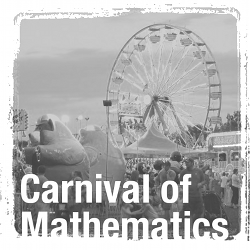Welcome, dear maths friends, to the 213th Carnival of Mathematics! It’s my pleasure to host you today. Get yourself a drink, settle down in a nice comfortable chair, and prepare to experience some mathematics.

While we’re waiting for everyone to arrive, take a moment to observe the curious specimen before you: the number $213$. If you look carefully you might notice something interesting about its digits: summing them and multiplying them give the same result. But there’s more to this number than that. Everybody talks about the Mersenne primes – prime numbers one less than a power of $2$. But there’s another class of prime, not so well known, whispered about in dark places: primes that are three less than a power of $2$. And $213$ gives us one such prime: $2^{213} -\, 3$. My eternal thanks to Colin Beveridge for scouring the deepest corners of the OEIS to bring me this fact.
But I can’t keep this carnivalistic role play up any longer, so on to the glorious mathematics! In no particular order…
We start with Imran Parvez Khan’s Sphere Packing Made Simple, an enjoyable summary of Maryna Viazovska’s work on sphere packing in higher dimensions.
Karen Campe has written about how she uses Same and Different prompts to encourage students to compare and analyse two mathematical situations. She has a huge library of prompts, suitable for different levels. What I love about this is that it’s a starting point to the type of mathematical thinking that can lead to new connections and exciting discoveries.
Matthew Scroggs has created a collection of datasets with the same mean and standard deviation whose graphs look like letters of the alphabet. You can even write your own messages: each of the letters in the image below is a graph of a dataset, all of which have the same mean and standard deviation. This is fun, but also highlights a serious point – datasets with the same summary statistics can have very different distributions.

Maths is famous! A Mathstodon thread about dividing a square into similar rectangles, started by John Carlos Baez, featured in a New York Times article this month. It’s a delightful celebration of the collaborative spirit on Mathstodon.
Larissa Fedunik-Hofman has posted about an interview with Francisco Crespo, who visited the Sydney Mathematical Research Institute to work on the full $n$-body problem, about the motion of rigid bodies in space.
Robin Whitty told the carnival about a new result about the density of a subset of integers required to guarantee the subset contains a 3-term arithmetic progression. Robin also submitted a blog post by Terence Tao musing about the possibility of creating a tool to automatically produce diagrams for papers.
There was sad news this month: David Singmaster, one of the greats of recreational mathematics, passed away. Rob Eastaway has written a beautiful post celebrating David’s life and love of puzzles.
Ioanna Georgiou writes about the dice game Kniffel or Yahtzee, which is a game I remember enjoying (but getting very frustrated at!) as a child. Although there is an element of luck, an understanding of probability will give you a strategic advantage.
Paulo Ferro sent in a sweet puzzle about a bird.
Finally, it’s time for the Chalkdust Book of the Year! The wonderful team at Chalkdust have put together a shortlist of seven excellent maths-themed books published in 2022, one of which will win the coveted title. Vote for your own favourite, and keep an eye on the Chalkdust blog to see the team’s reviews of the books.
That’s all for this month! I hope you’ve enjoyed this tour of the weird and wonderful world of mathematics. Next month will be hosted by Robin at Theorem of the Day. Use the Carnival page at the Aperiodical to submit any interesting maths content you see in the next month, or to volunteer to host a future month.

Leave a Reply